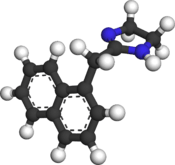Naphazoline
Naphazoline is a medicine used as a decongestant. It is a sympathomimetic agent with marked alpha adrenergic activity. It is a vasoconstrictor with a rapid action in reducing swelling when applied to mucous membrane. It acts on alpha-receptors in the arterioles of the conjunctiva to produce constriction, resulting in decreased congestion.
 | |
 | |
| Clinical data | |
|---|---|
| Trade names | Naphcon-a |
| AHFS/Drugs.com | Monograph |
| Routes of administration | Topical (solution) |
| ATC code | |
| Legal status | |
| Legal status |
|
| Identifiers | |
IUPAC name
| |
| CAS Number | |
| PubChem CID | |
| IUPHAR/BPS | |
| DrugBank | |
| ChemSpider | |
| UNII | |
| KEGG | |
| ChEMBL | |
| ECHA InfoCard | 100.011.492 |
| Chemical and physical data | |
| Formula | C14H14N2 |
| Molar mass | 210.274 g·mol−1 |
| 3D model (JSmol) | |
SMILES
| |
InChI
| |
| | |
It was patented in 1934 and came into medical use in 1942.[1]
Chemistry
The non-hydrochloride form of Naphazoline has the molecular formula C14H14N2 and a molar mass of 210.28 g/mol. The HCl salt form has a molar mass of 246.73 g/mol.
Side effects
A few warnings and contraindications that apply to all naphazoline-containing substances intended for medicinal use are:
- Hypersensitivity to naphazoline
- Patients taking MAO inhibitors can experience a severe hypertensive crisis if given a sympathomimetic drug such as naphazoline HCl
- Use in infants and children can result in central nervous system depression, leading to coma and marked reduction in body temperature
- Should be used with caution in patients with severe cardiovascular disease including cardiac arrhythmia and in patients with diabetes, especially those with a tendency toward diabetic ketoacidosis
- Drug interactions can occur with anaesthetics that sensitize the myocardium to sympathomimetics (e.g. cyclopropane or halothane cautiously)
- Exercise caution when applying prior to use of phenylephrine.
- Extended use may cause rhinitis medicamentosa, a condition of rebound nasal congestion.
A possible association with stroke has been suggested.[2]
Brand names
It is an active ingredient in several over-the-counter formulations including Rohto, Eucool, Clear Eyes and Naphcon eye drops.[3]
References
- Fischer, Jnos; Ganellin, C. Robin (2006). Analogue-based Drug Discovery. John Wiley & Sons. p. 552. ISBN 9783527607495.
- Zavala, J. A.; Pereira, E. R.; Zétola, V. H.; Teive, H. A.; Nóvak, E. M.; Werneck, L. C. (2004). "Hemorrhagic stroke after naphazoline exposition: case report". Arquivos de Neuro-Psiquiatria. 62 (3B): 889–891. doi:10.1590/S0004-282X2004000500030. PMID 15476091.
- Green, S. M. (2008). "Ophthalmology: Naphazoline". Tarascon Pocket Pharmacopoeia 2009. Jones and Bartlett. ISBN 0-7637-6572-4.